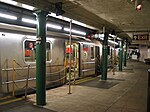Portal:New York (state)/Selected article/8

Transportation in New York is made up of some of the most extensive transportation infrastructures in the country, as well as one of the oldest. Engineering difficulties because of the terrain of New York State and the unique issues of New York City brought on by urban crowding have had to be overcome since the state was young. Population expansion of the state generally followed the path of the early waterways, first the Hudson River and then the Erie Canal. Today, railroad lines and the New York State Thruway follow the same general route.
Transportation was used early on to support industry and commerce in New York State. The Boston Post Road, between what was then the relatively small City of New York and Boston, began as a path to deliver the post using post riders (the first ride to lay out the Upper Post Road starting January 22, 1673), and developed into a wagon, or stage road in later colonial times. During the 19th century, pieces of the road were taken over and improved by turnpike companies. In the 1910s and 1920s, the Lower Post Road alignment (and realignments made to the route) was a National Auto Trail known as the Boston Post Road. Large sections of the various routes are still given the name Boston Post Road, much of it is now U.S. Route 1. By the American Revolutionary War, the colonial Province of New York was still small and relatively sparsely populated.
